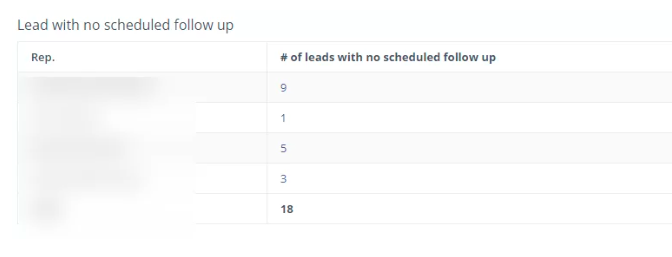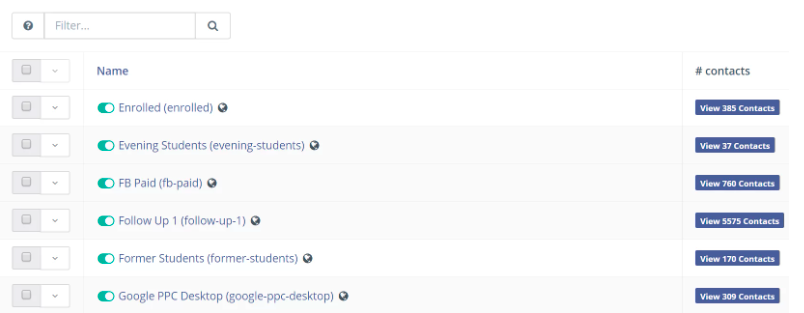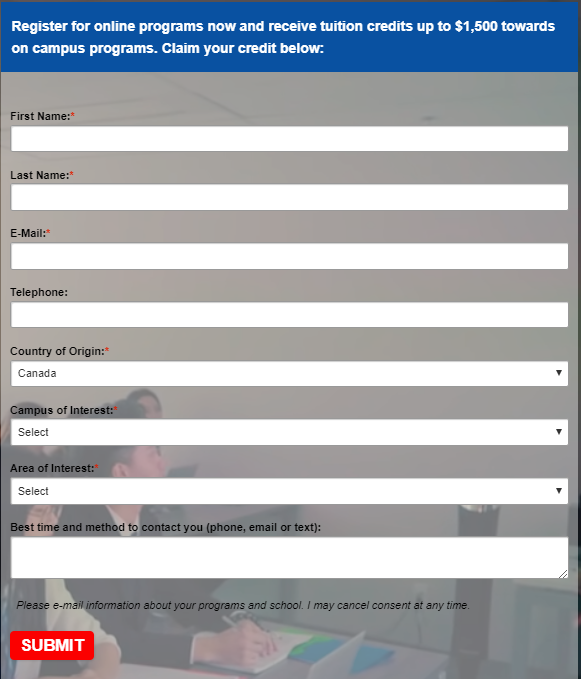
A CRM and marketing automation system can be a useful tool for admissions teams at the best of times. Allowing you to better manage your pipeline, scale your follow-up efforts, and measure the impact of your activities, these versatile platforms can be a godsend for multiple aspects of student recruitment.
In the midst of the COVID-19 pandemic, however, they are arguably even more essential. With staff forced to work remotely, resources stretched, and physical avenues for connecting with students closed, CRM and marketing automation can become a lifeline that helps your team maintain your student recruitment efforts. Here’s how.

1. Calendar Integration Can Help Education Pros Stay Organized Remotely
Student recruitment is a coordinated effort. Admissions, marketing, financial, and educational staff often need to work closely together to plan their future activities, allocate their work, and keep track of their progress.
As such, these functions will arguably suffer more than most from the current social distancing measures. Working from home, it will be easy for communication between your staff to break down from time to time, resulting in missed deadlines, skipped meetings, and other problems.
While you can use shared calendars like Google Calendar to manage your activities, centralizing this process in your CRM and marketing automation system has several advantages. For a start, any activity you set in relation to a specific contact will be automatically added to your calendar. Activities can also be categorized and colour-coded to make it easier for you to see exactly what your day looks like at a glance.
Example: This calendar view in HEM’s Mautic CRM and marketing automation for schools displays meetings in purple, calls in yellow, and to-dos in red.

You can also manage your permissions to determine what calendars will be visible to each staff member. Managers, for instance, may want to view the calendars of their entire team in order to organize their workload. Managers can also assign tasks to specific users from the calendar itself:

This means that they can see who has bandwidth for work, and quickly assign what they need done, all in one simple view. It’s a simple, straightforward change that can make a massive difference in your planning.
2. Admissions Staff Can Use CRM to Log Calls and Other Outcomes
How often do your managers or teammates check in with you to find out how a particular call or meeting with a prospect went? How many times will they ask if you’ve sent a particular email, or received a response? How many times do you sit down with teammates to fill them in on a specific lead’s situation or preferences?
These simple exchanges are often the first thing that gets lost when you move from an office environment to remote work, as your staff is used to being able to quickly check in with one another at any time. While chat and video call apps can make up for it somewhat, your working rhythms will be disrupted, and the extra few seconds it takes to use these tools compared to speaking to someone in the same room as you will add up quicker than you think.
That’s why utilizing the activity logging and notation features CRM systems offer can make such a difference for admissions teams in this situation. Your staff can log calls, emails, and other messages sent to leads within their contact profiles, as well as any responses received. You can also make notes about the outcomes of your efforts and any specific, pertinent information you feel people need to know.
Example: You can make notes in Mautic to document specific information about contacts.

Thus, any member of your team who opens a specific contact profile will see a full, detailed history of that lead. This can be especially important if your team’s resources have been stretched during the current crisis. With many schools taking a financial hit, you may have had to temporarily lay off staff or reduce their hours, which may mean some team members need to share work, or take over following up on leads that they are not familiar with.
By ensuring that anyone on your team can find out everything they need to know about each prospect easily, you can ensure continuity, guard against mistakes, and give your staff the best chance of success.
3. Tracking Productivity is Easy with CRM for Schools
Another aspect of ensuring your admissions office runs smoothly during the lockdown is monitoring productivity. As hard as your staff might work, there may still be places where your in-office work doesn’t translate to a remote environment as well, and your managers will need to coach staff to improve their output.
There may also be areas where you have an opportunity to enhance your processes. A good example is how quickly your team is following up with leads. Before the lockdown, your staff may have been used to a daily routine where they had more other work to engage in, such as meetings, business trips, campus tours, and processing work. As a result, they may not have been following up with every single lead as quickly and diligently as they could.
However, with much of that taken off their plate, together with what is likely a smaller pool of prospects to deal with, they should be making an effort to connect early and often. Many CRM systems offer a number of reporting functions precisely for this purpose, allowing your managers to see at-a-glance what follow-up activities your staff are engaging in, how quickly they are doing it, and crucially, what is falling through the cracks.
For example, HEM’s customized Mautic CRM for schools comes equipped with a number of out-of-the-box reports for this purpose. The Speed to Lead report enables you to see how soon your team are dealing with new prospects after they arrive in your inbox:

You can also monitor how are they following up with these contacts with the Admissions Activities report, which tracks emails, calls, and SMS sent by each team member:

The Leads With No Scheduled Follow-up report can also be invaluable in this situation, as it helps you flag prospects who might be falling by the wayside:

There could be any number of reasons this is happening, from issues with lead assignment to flaws in your defined follow-up workflows. Tracking these issues will allow you to find out where you are going wrong, and work to fix the problem.
4. Measure the Effectiveness of Your Student Recruitment Efforts During the Lockdown
During the lockdown, your managers should also be paying close attention to the success rate of your contact attempts. If your school has traditionally relied upon in-person recruitment methods such as fairs, open houses, and campus tours to nurture leads towards application, it’s natural that you will find it harder to achieve the same results remotely. The uncertainty created by the COVID-19 crisis is also likely to make some prospects more reticent to fully commit to making study plans.
Closely monitoring the outcomes of your team’s efforts can help you to identify what methodologies give you the best chance of success, allowing you to redefine your follow-up process accordingly.
You should start by monitoring your success rate channel by channel. See whether prospects are more likely to respond to calls, texts, instant messaging, email, or a combination of these.
Example: The Mautic Calls Outcome report will tell you how likely you are to connect with prospects by phone.

Your team can use this information to determine the optimal channels for connecting with your prospects and work on improvements to your approach.
Even more crucially, CRM systems also allow you to measure what methods actually convert leads into students. The Lead Conversion report in Mautic, for instance, shows total leads by contact owner, the percentage that each owner has successfully contacted, and the percentages that held meetings, submitted applications, and ultimately enrolled.

Given that the current crisis is uncharted territory for schools, there is likely to be a lot of trial and error as we move forward. Seeing what is bringing success can give your team food for thought as they attempt to develop a new working routine.
5. Segmentation in CRM for Schools During the COVID-19 Crisis
The unfortunate truth is that the COVID-19 crisis has likely already disrupted your lead flow in many ways. Certain audiences – such as international students – may have had to put their study plans on hold indefinitely. Interest in particular courses has also likely waned, whether because they are not offered online or just don’t hold the same attraction as they did before the outbreak.
In contrast, you may also have seen a spike in interest in particular areas. Online or professional development courses may now be subject to more inquiries than before, or your school may have seen an increase in inquiries in general from people looking to retrain for different careers after being laid off.
Whatever situation you find your school in, your team will want to prioritize the prospects that are most likely to move towards application, and that is where CRM and marketing automation systems come into play. CRMs allow you to segment your contact lists in order to better plan and prioritize your follow-up schedule. You can group prospects by location, program, or any other parameter in order to ensure that the right leads are being targeted with the right messages at the right time.
Example: This school has segmented contacts according to various criteria in Mautic, including channel and course schedule.

This task doesn’t need to be hard work, either. By taking care to structure your forms to gather whatever relevant information you need, you can ensure that all new leads are automatically segmented based on the criteria you specify.
Example: This Request Info form on Canadian Tourism College’s website includes fields that will gather information on the prospect’s location, their area of interest, and the campus they are considering. When the form is filled out, the school could use a CRM to automatically add a new lead to a segment based on any of this information.

You could take this a step further by implementing a lead scoring system and allocating scores to specific attributes, providing your software has this functionality.
Segmenting prospects by stage in the enrollment journey could also be especially important at this juncture. With so much uncertainty about what the coming months will bring, prospects are likely to take a bit longer to move through the funnel than usual. Even if your school has seen an uptake in inquiries from people reconsidering their options in recent months, it could be a while before they are ready to go further.
As a result, monitoring what your pipeline looks like could be extremely valuable in helping you determine where best to allocate resources and focus your team’s efforts.
6. Automate Your School’s Communications to Do More With Less
Marketing automation functionality could also be a godsend for your school during the crisis, particularly where it enables you to automate communications. At a time when your team’s resources might be stretched, the ability to scale this area of your follow-up efforts might be very welcome indeed.
Creating email campaigns, for instance, could help your school to ramp up its marketing and lead nurturing efforts at a very low cost. Developing autoresponders that trigger when a prospect makes an inquiry might also be a good idea. Prospects who inquire online expect quick response times, and ensuring you make an immediate effort to connect could stop them from moving on and looking elsewhere.
You could also create a series of email templates that answer common queries, such as questions about options for financing, or even your school’s COVID-19 response, and save them in your system. That way, your team can quickly pull out the information when speaking to prospects, and send them a readymade answer right away.
However, it is important to look beyond email. Many schools are finding increased success using SMS and instant messaging campaigns to connect with prospects, and if your team are devoting more of their time to working on remote follow-up, now might be as good a time as any to experiment with these channels.
Some – but not all – CRM and marketing automation systems will give you the facility to do this. HEM’s customized Mautic CRM system, for instance, allows you to send SMS directly to contacts from your system, and even to use pre-prepared templates for your messages.
Example: You can send SMS to contacts on Mautic to follow up on their interest, remind them of upcoming deadlines, and answer questions. Selecting Import from an existing template allows you to use a previously prepared message.

As much as marketing automation for schools can help you save time and reach more prospects, it’s important to understand when to take a manual approach, too. At certain points, your prospects are likely to prefer being contacted directly to talk about your school and their individual needs in more detail, particularly during turbulent times like these. A combination of both approaches is usually the best formula.
7. Designing Your Perfect Workflows with CRM and Marketing Automation for Schools
By combining segmentation, task management, and both automated and manual communications, you can create detailed admissions workflows that will provide a roadmap for your team to manage its pipeline in the current crisis.
Whenever a new inquiry comes in, they can be automatically assigned to a specific staff member depending on what segment they fall into, your staff’s availability, or whatever else makes it easier for you to manage.
Example: A simple lead assignment workflow in Mautic.

From there, all of your follow-up activities, whether automated or manual, can be mapped out at regular intervals. Emails or messages can be automatically sent after a given time or after a specific action is taken. At the same time, you can also trigger notifications to be sent to your team when it is time to schedule manual tasks.
Of course, not all leads will respond to your follow-up attempts in the same way. Some might be eager to connect with you and move towards application, while others might not answer you at all. For this reason, most CRM and marketing automation platforms allow you to build conditional branches into your workflows, which use the previous outcomes to dictate what the next step should be in each individual case.
Example: A workflow in Mautic which sends emails in cases where a school has failed to make contact with a prospect.

Putting this kind of system in place could be a great relief for your team, helping them to establish more of a routine and order to their work at a time when they have experienced great upheaval and stress. What’s more, it will help ensure that your student recruitment activities remain as efficient and productive as possible for as long as the crisis continues.





